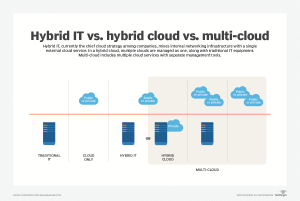By Des Nnochiri
Most enterprises now use two or more cloud service providers, and 35% use up to five monitoring tools to keep tabs on hybrid cloud and multi-cloud environments. Even before organizations began shifting software and IT infrastructure to the cloud, a typical business would use four to ten tools just to monitor and troubleshoot their internal networks, according to analyst and consulting firm Enterprise Management Associates.
While extending the range and computing power of their users, cloud environments introduce their own set of complications when it comes to monitoring. In this article, we’ll be looking at some techniques and best practices for hybrid and multi-cloud users.
The Need for Enhanced Monitoring in the Cloud
Traditional monitoring tools focus on the health and performance of individual network elements. The public cloud particularly makes it difficult for administrators to achieve and maintain full network visibility. Organizations doing business in the cloud require a holistic view of their networks. In the digital economy, they also require the ability to manage data from a range of sources and to extract insights from the cloud using analytics and machine learning technologies.
Hybrid Cloud vs. Multi-Cloud
The term “multi-cloud” may be used to describe any IT environment in which an organization uses two or more distinct cloud service providers. According to a recent survey by Kentik![]() , 40% of enterprises consider themselves to be in this category.
, 40% of enterprises consider themselves to be in this category.
Hybrid cloud describes a situation where an organization uses at least one cloud service provider in addition to its own traditional on-premises IT infrastructure, co-located resources, or a third-party data center.
Users of both types of cloud environment may encounter a common set of problems when it comes to monitoring. With numerous and diverse sources contributing data to their network, it’s necessary to collect and analyze a wide range of information, such as data packets, system logs, and device metrics. In the current market, few (if any) single vendors provide tools for doing this all.
Due to this, 35% of multi-cloud users typically have three to five monitoring tools, including log-management tools (48%), application-performance-management tools (40%), open-source tools (34%), and network performance management tools (25%).
For hybrid cloud users, the existing breed of device-centric network monitoring tools can’t scale up easily or provide the visibility needed for cloud and digital business applications. Monitoring tools provided by cloud services such as Amazon CloudWatch, Azure Monitor, or GCP Stackdriver often lack the features and visibility required by specific industries and may not integrate well with on-premises tools.
Using APIs to Integrate Visibility
A management system application programming interface (API) that’s used to pull information from other platforms can be one of the most valuable sources of data for a network monitoring tool. Network administrators also gain access to features such as custom data collection, tool customization, and the ability to build new dashboards that allow them to visualize the cloud in ways specific to their own businesses.
Some legacy management systems such as SolarWinds’ advanced network monitoring for on-premises, hybrid, and cloud have been actively expanding into cloud-native environments, with tools that give administrators the option of monitoring both existing on-premise systems and their cloud infrastructure. Unfortunately, these providers tend to be in the minority.
While older infrastructure vendors may be slow to open up their APIs to consumers because they believe the data they produce with their analytics to be proprietary, most newer vendors will supply the kind of API needed for this type of cloud monitoring.
Using What the Cloud Service Providers Have to Offer
For cloud native and multi-cloud environments, cloud providers are beginning to allow more consistent access to tools that monitor the networks that operate on their platforms. As an example, Microsoft Azure has added an option called Virtual Network TAP, which allows subscribers to continuously stream virtual machine network traffic to a network packet collector or analytics tool. This collector or analytics tool is provided by a network virtual appliance partner.
Combining Monitoring Across Multi-Cloud Environments
An emerging breed of adaptable tools such as ThousandEyes, Kentik, New Relic, and Dynatrace provide features like the ability to support collaboration with product development and other infrastructure teams and the power to integrate data from multiple sources. Some also allow hybrid cloud users to factor in elements like cost and capacity management.
Using AIOps and Advanced Analytics Platforms
With the rise of new technologies, network monitoring is now as much about data handling, as it is about troubleshooting. These needs are fueling the development of artificial intelligence for IT Operations (AIOps), advanced analytics platforms, and machine learning tools which can correlate insights across various tools. For example, the network vendor CA has built an artificial intelligence platform called Jarvis, which plugs into different parts of their tool portfolio to correlate insights across them.

A Distributed and Software-Defined Future
Best practices for hybrid cloud monitoring require a heterogeneous approach and a balance between internal and external resources. Rather than relying on traditional infrastructure tools, Gartner, Inc. advises users to adopt cloud native tools, as opposed to trying to bring their internal tools into the cloud. A data-driven network monitoring framework is also recommended for boosting network visibility across multiple cloud services.
In addition, some network analysts![]() see the future of networking as software defined, with distributed rather than centralized intelligence or control. This new breed of networking demands the same philosophy of automation, infrastructure, and code techniques that have disrupted other areas of IT management. A data-centric framework holds the key for building the types of network monitoring platforms that will survive or support some of these evolving architectures for hybrid cloud and multi-cloud environments.
see the future of networking as software defined, with distributed rather than centralized intelligence or control. This new breed of networking demands the same philosophy of automation, infrastructure, and code techniques that have disrupted other areas of IT management. A data-centric framework holds the key for building the types of network monitoring platforms that will survive or support some of these evolving architectures for hybrid cloud and multi-cloud environments.

